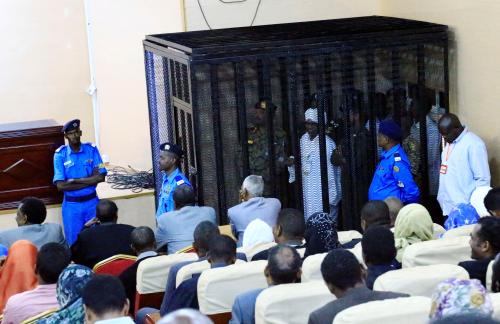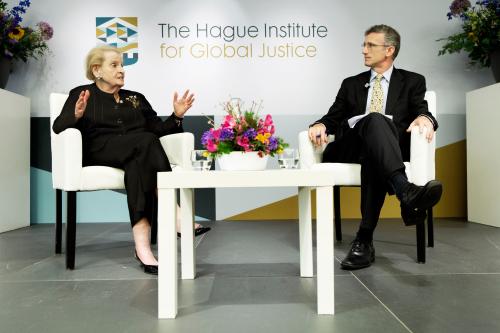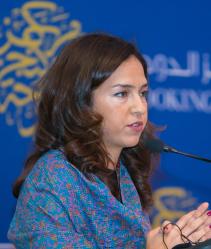Content from the Brookings Doha Center is now archived. In September 2021, after 14 years of impactful partnership, Brookings and the Brookings Doha Center announced that they were ending their affiliation. The Brookings Doha Center is now the Middle East Council on Global Affairs, a separate public policy institution based in Qatar.
The chemical weapons attack in the Syrian town of Khan Shaykhun earlier this month has led to renewed calls for members of the Assad regime to face justice. Boris Johnson and Jean-Marc Ayrault recently wrote in The Guardian, for example, “there will be no impunity.”
But promises by the international community to pursue justice in Syria are all too often short sighted and impulsive. They fail to consider how such promises will be carried out. If arrest warrants are issued, especially ones that target members of the Assad regime, who will arrest them? It is one thing to issue an arrest warrant; it is quite another to enforce it.
The problem with arrest
Judicial bodies set up to establish individual responsibility for the atrocities committed in Syria since 2011 have an important mandate—however, they have no teeth. International tribunals do not have their own police force. Instead, they rely on state cooperation to arrest suspects.
As a result, arrest warrants can linger for years, leaving victims in limbo as they wait indefinitely to see their perpetrators held to account. Since 2009, for instance, Sudanese President Omar al-Bashir has had two International Criminal Court (ICC) arrest warrants lingering over his head for charges of war crimes, crimes against humanity, and genocide in Darfur. Eight years later, the Court and those who advocated for its involvement continue to wait for his arrest in vain.
When arrest warrants linger like this, it seriously damages victims’ faith in achieving justice (or at least those victims who are not yet disillusioned by international law).
The problem with trial
Moreover, without a realistic plan for how to ensure an actual trial takes place, knee-jerk justice promises unnecessarily raise the expectations of victims and set them up for major disappointment.
The prospects for fair trials that address the Syrian conflict are extremely weak. The ongoing violence and the practical challenges to ensuring that suspects are physically present at a trial only scratch the surface of the enormity of the task.
If a high-level Syrian suspect were to be tried, where would this trial take place? Ongoing violence and a deeply polarized judiciary would make Syria a very unlikely venue. If a trial were held inside Syria, we could be looking at another trial a la Saddam Hussein: limited in its charges, highly politicized, and rushed without due process, leaving many victims disappointed.
An international or even a hybrid tribunal would also face considerable challenges. Would the multiple parties to the conflict be investigated and tried for the atrocities committed since 2011? Who would ensure their arrest, custody, and physical transfer to the location of the tribunal? Would accused perpetrators be given a platform to spew political rants and posturing for the history books? And would victims from all sides be able to provide testimony without fear for their safety? What about the victims of both Assad regimes, pre-2011? Would they be given the opportunity to see their perpetrators on trial and to establish some form of truth regarding pre-2011 abuses? Would Syrian state agencies cooperate to enable the collection of evidence?
Pros and cons to international efforts
To be sure, calls for justice in Syria are not premature. If anything, they are very late, given that horrific atrocities have been committed in Syria not just since the 2011 uprising, but also for decades under both Assad regimes. The chorus of demands to hold Syrian war criminals accountable has led to some international activity around the issue.
A few days after the chemical attack on Khan Shaykhun, several U.S. senators introduced the Syrian War Crimes Accountability Act. It calls for the potential creation of a hybrid tribunal “to hold Assad and his regime accountable for their heinous acts.”
Efforts to trigger universal jurisdiction laws in Germany, Spain, Sweden, and other countries have been somewhat successful. A Spanish court is investigating the role of President Bashar Assad’s security forces in “state terrorism,” following the kidnapping, torture, and execution of a truck driver in 2013. While this case addresses a single act as opposed to the systemic crimes being committed in Syria, it is a landmark case, as its investigation targets the Syrian leadership. But an arrest warrant in that case remains elusive.
Some would argue that some justice is better than no justice—that identifying the perpetrators by name and shaming them is in and of itself a form of justice. But naming suspects falls far short of any meaningful accountability. The absence of trials and verdicts only deepens the black hole of unanswered questions regarding who is responsible for such heinous crimes. For many, the fugitive lifestyle of named suspects—such as that which Omar al-Bashir has been comfortably leading since 2009—only compounds their sense of victimization, this time by an international criminal law that relies on the (non)cooperation of states to enforce its edicts.
There is also the broader question of whether the pursuit of criminal accountability in Syria harms the prospects for a resolution to the conflict. Thus far, neither peace nor justice has been achieved. In Yemen, immunity for former President Ali Abdullah Saleh has facilitated his thunderous political comeback. Embroiled in a brutal civil war that, like Syria, has several regional actors involved militarily, Yemen has seen neither peace nor justice since 2011.
While calls for justice are typically reactive, they must not be reckless.
In such a complex, deadly, and gruesome conflict, the priority is clearly to find a way to end the violence in Syria. There are no reassurances, however, that the conflict will end soon.
The Chinese and Russian veto of a U.N. Security Council resolution that would have referred the Syrian situation to the ICC was a blow to those seeking accountability in Syria. Hopes were then raised with the creation of the International, Impartial and Independent Mechanism (IIIM) to assist in the investigation and prosecution of those responsible for the most serious crimes under international law committed in Syria.
Such mechanisms, however, still have to contend with the challenge of establishing responsibility for individuals engaged in an ongoing and raging conflict. An ICC referral might have marginalized the Assad regime in certain international circles. But it would also renew accusations that the Court is imperialist, prosecuting the weaker countries and not the more powerful ones. Regardless, if Sudan provides any example, criminal charges would not necessarily help bring the conflict to an end.
It is, then, crucial to take a step back and consider other more realistic options for the pursuit of justice—whether now or in post-conflict Syria.
This is why the heroic efforts of Syrian activists, lawyers, civil society organizations, victims, and witnesses to document violations in Syria are vital. Such documentation is a treasure trove for investigations and future prosecutions. But it also lays the foundation for a meaningful national reconciliation process, the preservation of memory, and a potential truth commission.
While calls for justice are typically reactive, they must not be reckless. Empty promises of holding perpetrators to account will only further torment victims of the deadliest conflict of the 21st century.










Commentary
The perils of impulsive promises for justice in Syria
April 24, 2017